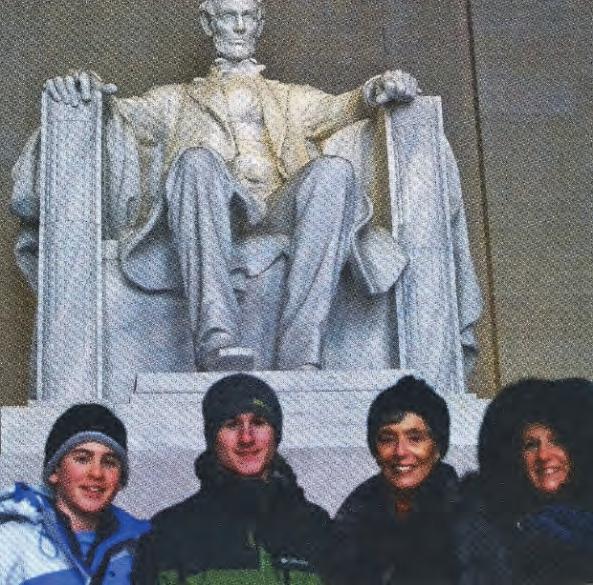
30 minute read
Appendix
by Udon Map
From my cousin, Paul:
Margie and my mother were close when they were children, so it was probably inevitable that she and I would be seeing a lot of each other. And once she moved to Newton Centre, that made it easy. My first distinctly clear memory of a specific time with Margie was the night that she took me to the movies. My mother drove me over to her house (87 Gray Cliff Road in Newton Centre). Margie made dinner, then we were going to the movies. She made vichyssoise. It was the first time I had had it, and I loved it. She served it cold, and to this day, I prefer it that way. I can actually still see her kitchen in my mind, sitting at the table, eating, etc. My memory of that evening is very clear. Then we went to the movie. In Cold Blood. Great movie. Turns out that she and I both like horror movies.
Advertisement
It’s funny how insignificant details sometimes stick in your mind. I used to ride my bicycle to Newton Centre on some Saturdays to have lunch with my father. Many times I also rode to Margie’s after lunch to visit, and she was always so happy to see me. I would just hang out with her for an hour or two, do errands with her, follow her around the house. She always made time for me, made me feel special to her. And she does to this day.
She eventually married Tom and moved to Rye. I graduated high school, went to Penn in Philadelphia, and I remember taking the train to Rye for many long weekends. Tom had a velvet easy chair in the den/sitting room, which I loved sitting in. I really liked Tom, and loved that he allowed me to sit in his chair. When I was there, they always had wine and cheese in the late afternoon. It was just a nice, relaxing time together, sitting around and talking. When I was in college, Margie’s house was my second home. I always slept in the same room upstairs, next to Wendy’s room. It felt so good to be there. Margie and Tom used to have grand New Year’s Eve parties. I went once. Tom knew that I liked wine; and at one point in the evening, he gathered me and two or three other people to go off into a side room where he opened a very special bottle of wine for us to enjoy. Tom was always very kind to me, and like Margie, always went out of his way to make me feel special.
I continued my regular visits to Rye after college, and still visit Margie regularly today.
Tom didn’t really like movies, and Margie and I both do. Particularly trashy horror films. So when I was there, she and I often went to the movies. The one I remember most clearly was called He Knows You’re Alone, which was also Tom Hanks’ film debut. The scene that both Margie and I remember so clearly was, as described in Wikipedia, “Amy returns and is attacked by Ray after discovering Nancy’s severed head in the fish tank.” When the head-in-the-fish-tank flashed on the screen, we both turned to each other, grabbed each other and screamed. I’ll never forget it! It’s the only time I’ve screamed in a movie!!
Margie and I travel together, too. One year, we met in Rome. Our flights were scheduled to get in around the same time, so we decided to meet in the airport. I walked into the baggage claim area of Fiumicino Airport, and there was Margie, sitting on her suitcase in the middle of the floor. The theme of that trip was saldi. Every time we walked by a store that had a SALDI sign in the window, Margie went in. And bought something.
We had the most wonderful dinner in Rome, at La Pergola Restaurant, the only three Michelin star restaurant in Rome, in what was then the Cavalieri Hilton (now the Rome Cavalieri Waldorf Astoria). The hotel is outside the city on a hill, and the restaurant is on the top floor of the hotel. We sat in the outside area on the roof, with a view over all of Rome. There was a string quartet playing by the pool on the ground below, and the music just wafted up to us. It was a such a lovely evening. We stayed at the top of the Spanish Steps in the Mediterraneo, next to the Hassler, in the cheapest rooms they had. Our rooms were next to each other. Walk-in closets are bigger than those rooms were.
A few years ago we were in Bangkok together for a day; she was in on a cruise that stopped in Bangkok. I set up a day of sightseeing and off we went! We saw and did so much. Erawan Museum (multi-story high threeheaded bronze elephant), Wat Traimit (Temple of the Golden Buddha), Jim Thompson House, and so much more. And, of course, shopping, as always. Around five in the afternoon, we headed back to my hotel to wash up,
Margie wanted to shower, I thought that we’d have a drink and relax a bit. At least that was my idea. I was pretty well worn out; it had been a very full day. On the way back to the hotel, Margie only had one question for me, -- where are we going next? I was dead tired; she, 20 years older, was, and is, indefatigable.
I have so many memories with Margie, it’s hard to select just a few from a lifetime. She is a wonderful cousin and friend. We talk about everything, from politics to religion to travel to food to our crazy family. We are silly with each other, laugh together, bounce ideas off each other. My life is so much better for having her in it.
Shopping in Dubai!
At the Sheikh Zayed Grand Mosque Abu Dhabi
My amazing trip to Saudi Arabia inspired this article.




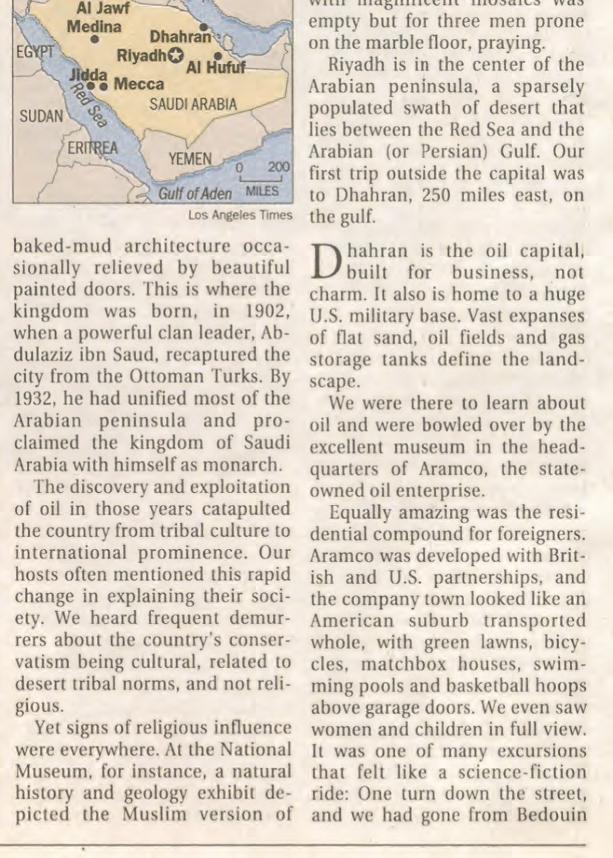

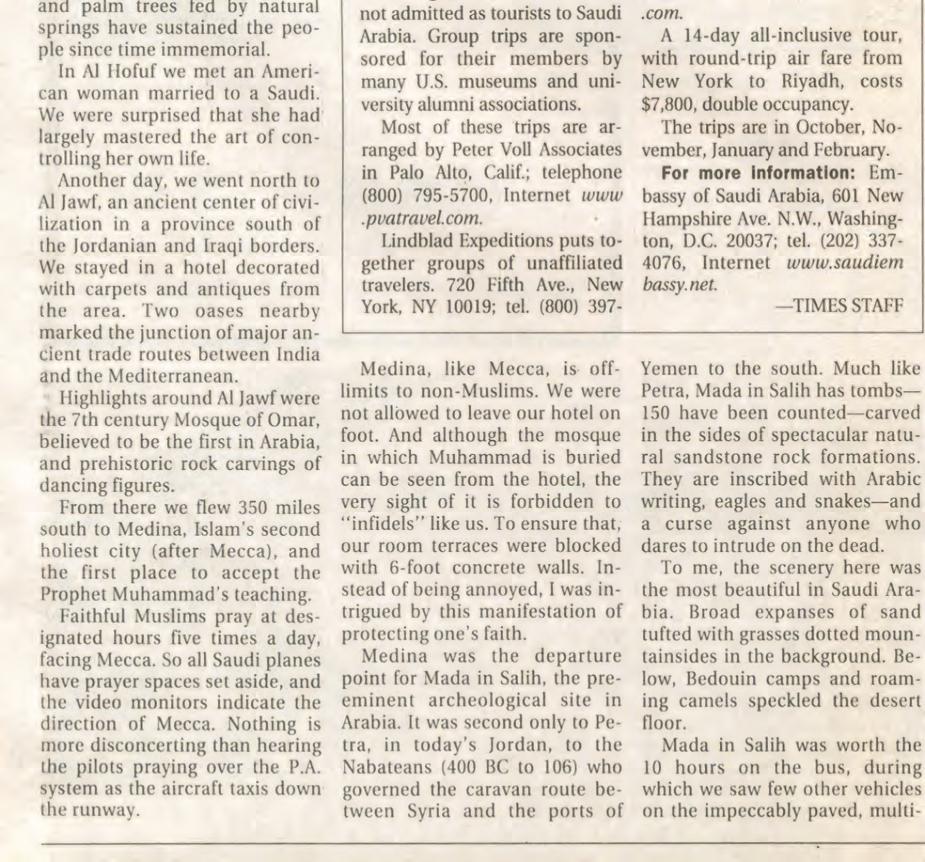


In July, 2001, I traveled to Alaska with a Smith College Alumnae group. As the official reporter, I published the following in the Smith Alumnae Quarterly issue of Winter 2001/2002:








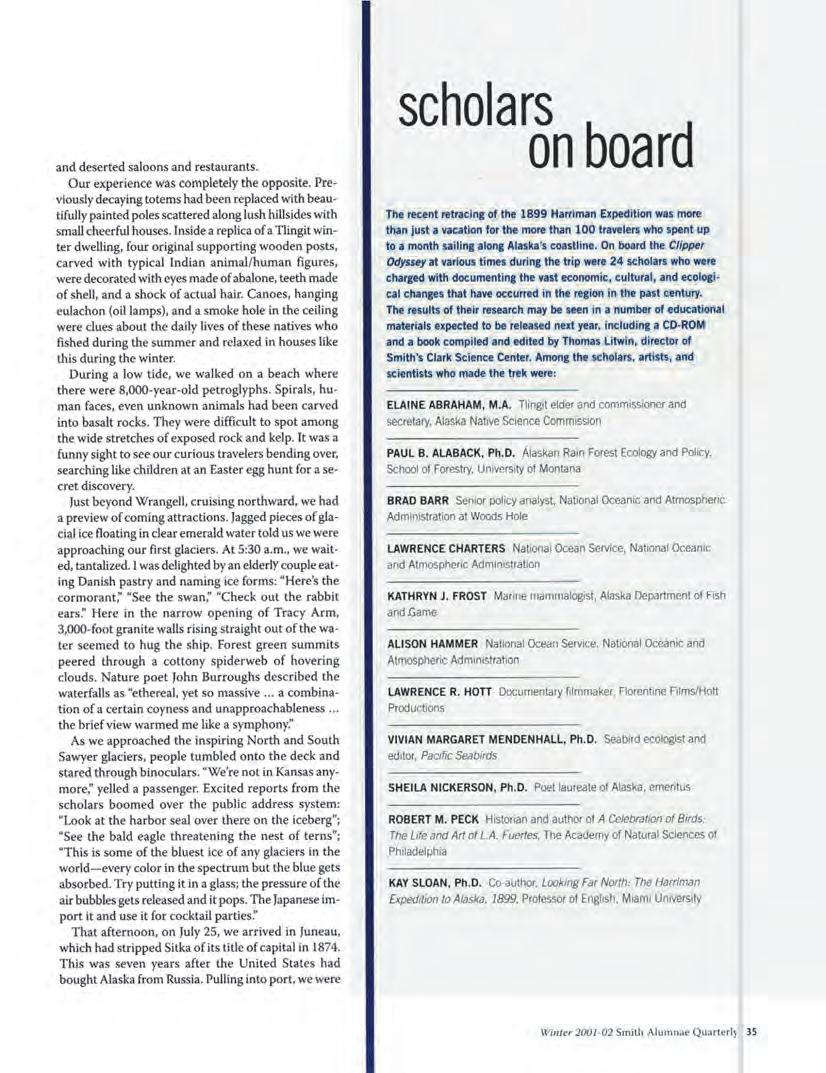
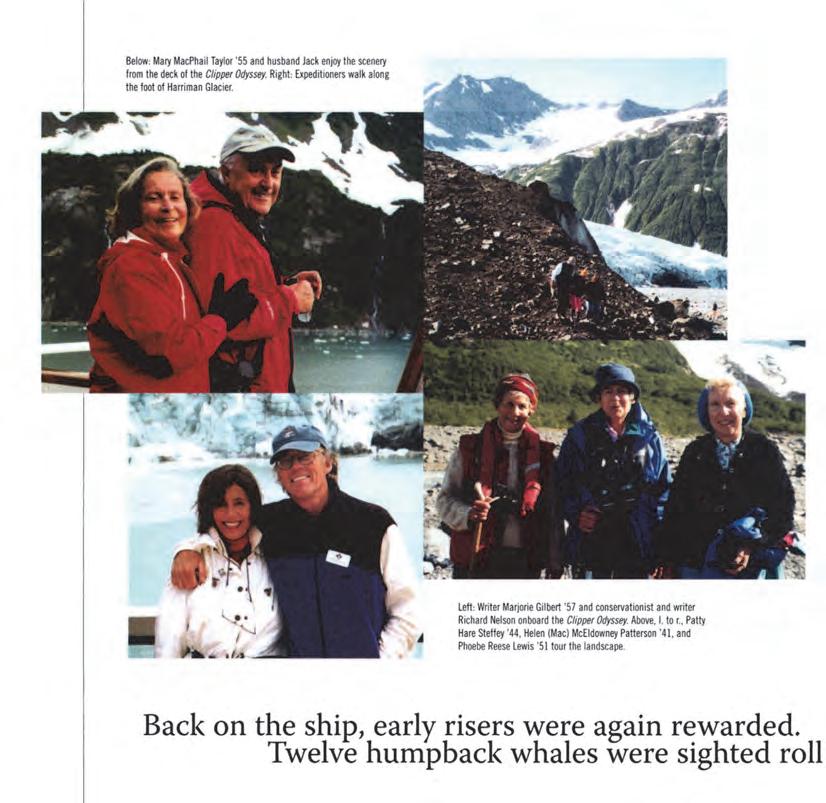





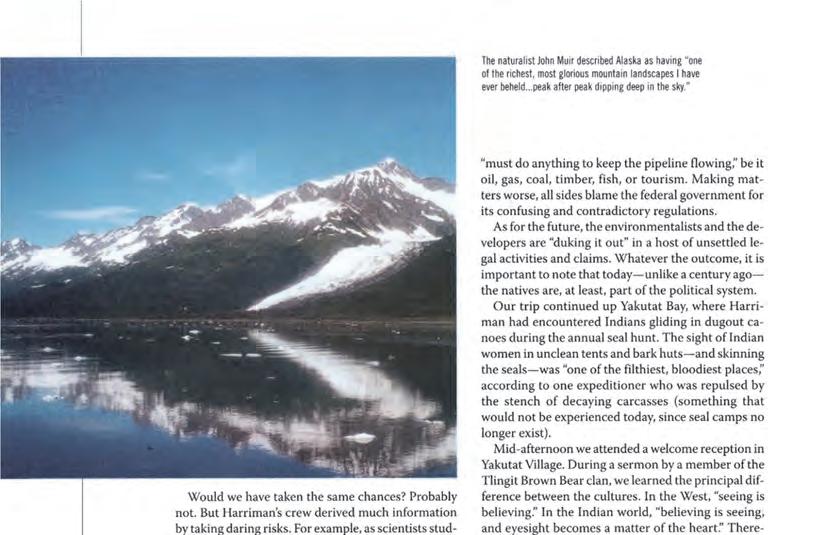


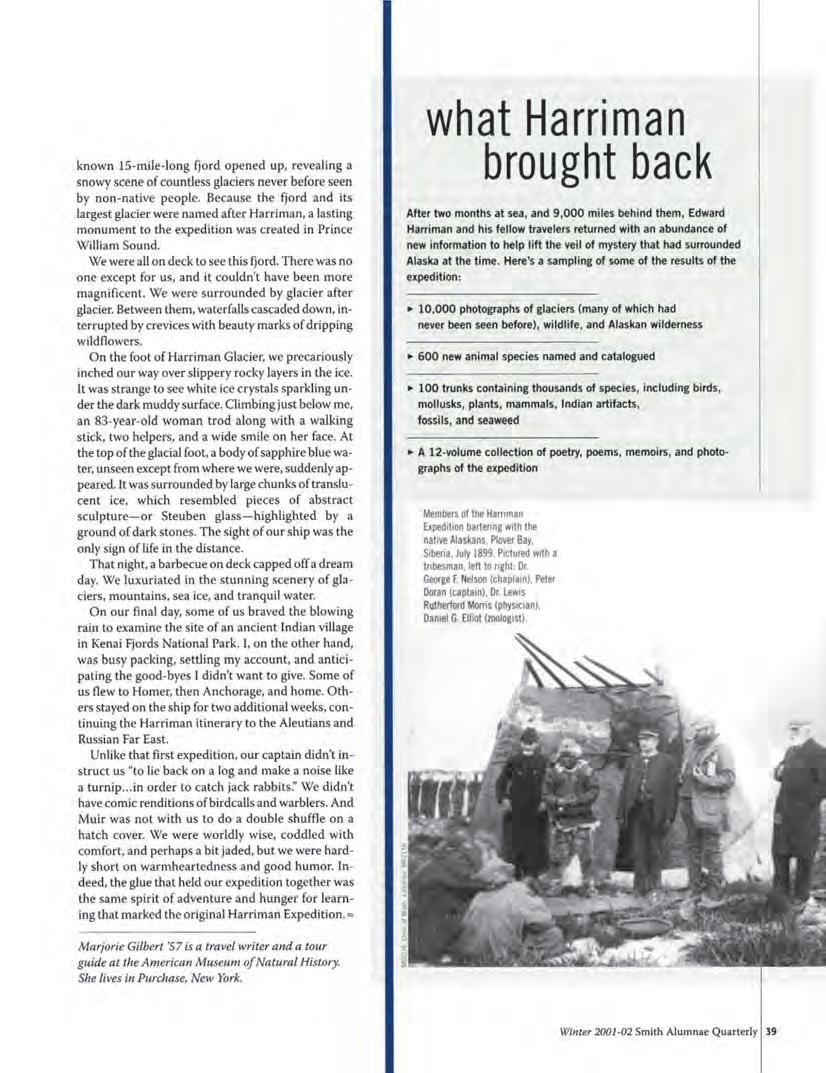

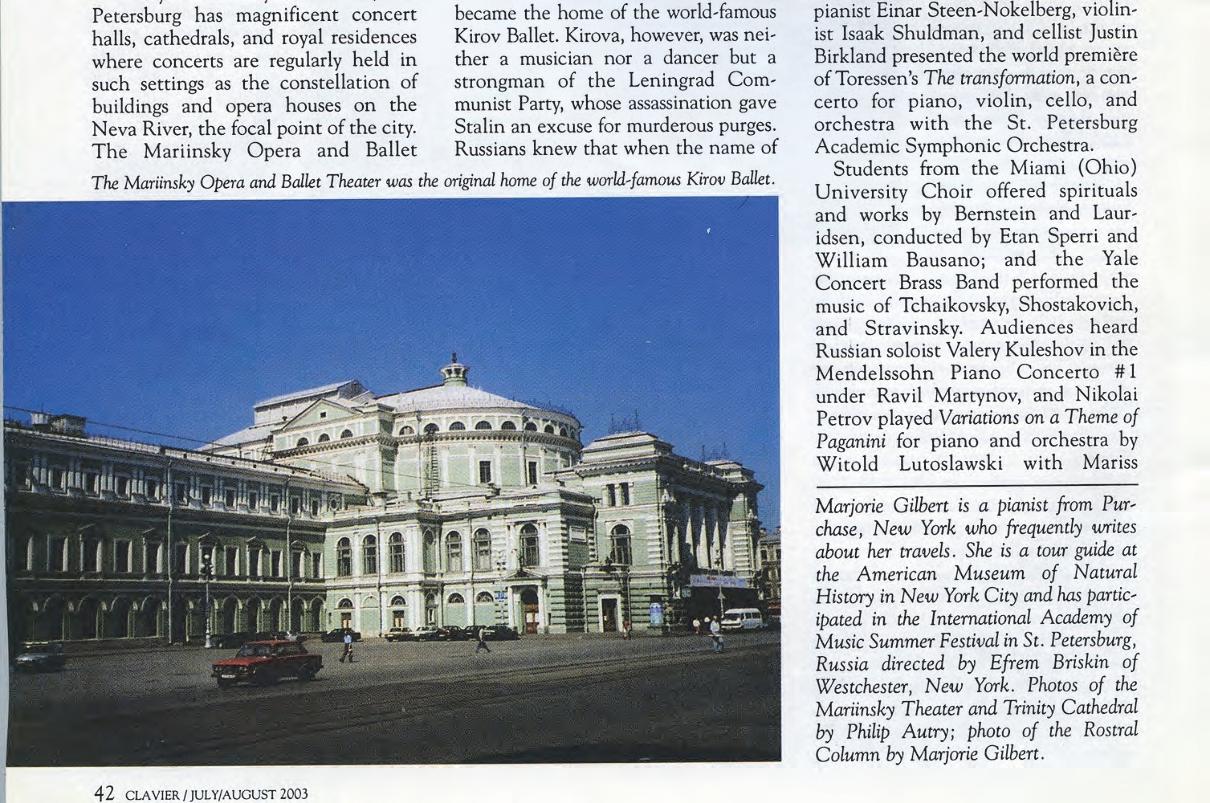
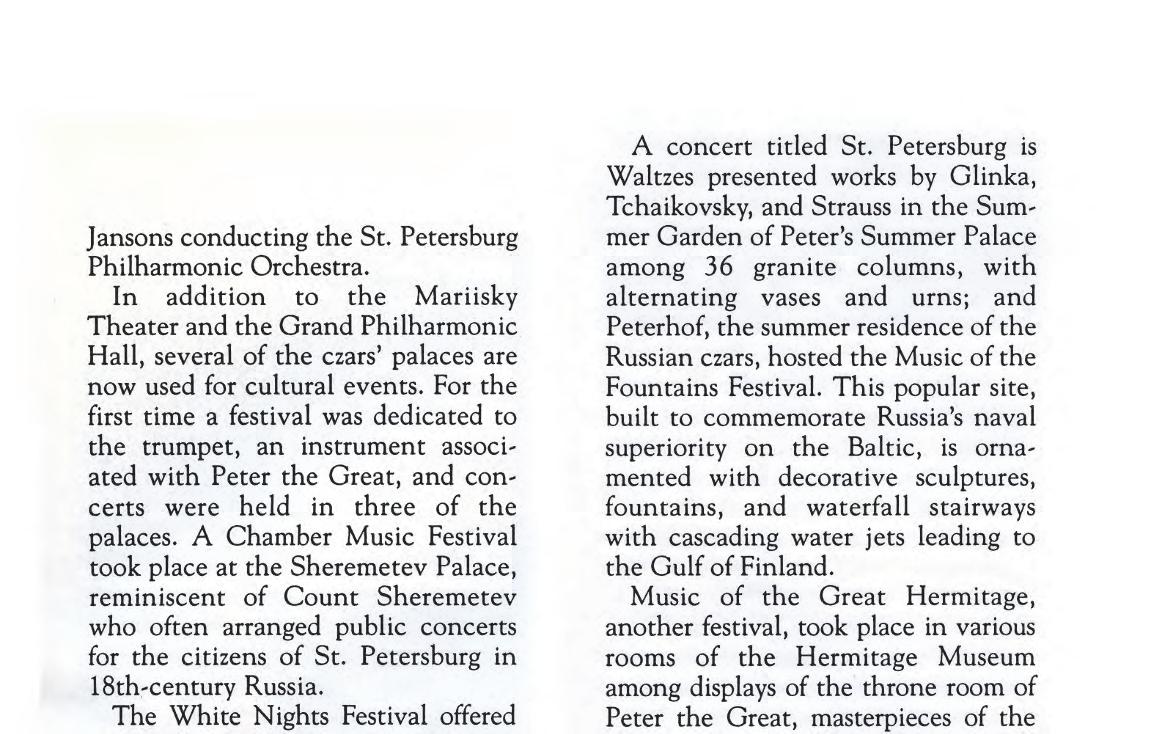



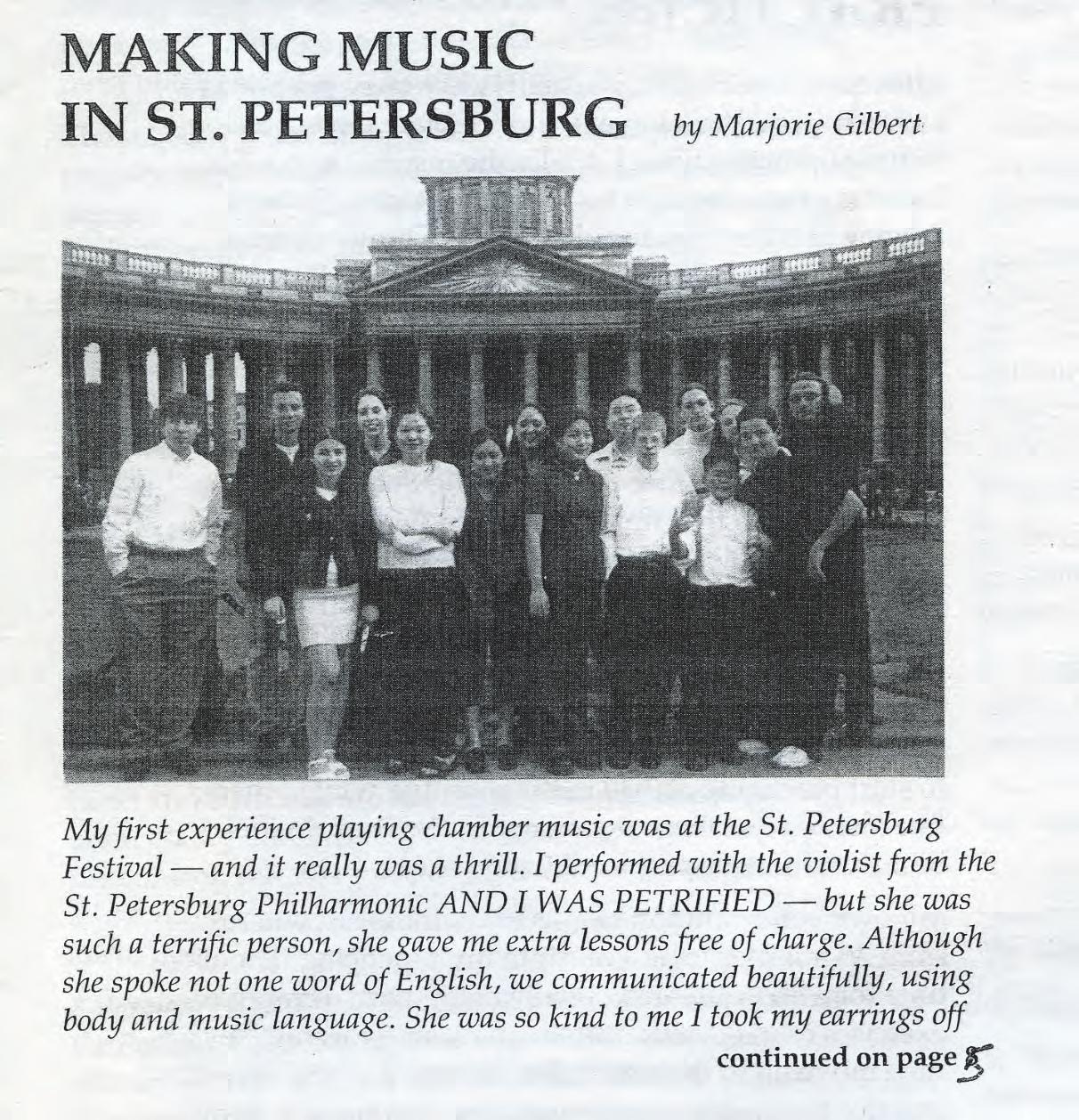


With a student At the Hermitage



Inle Lake, a Sweet Memory of Burma
By: Marjorie Gilbert
Every few years, when a severe case of wanderlust strikes, I find myself yearning to travel to places both exotic and far away. This year, I chose the most unlikely destination I could imagine. I have long been entranced by Burma, now called Myanmar, and the thought of this striking and far removed place served as my recent adventure.
Although war torn and repressed, Burma would be certain to yield its remaining untouched beauty and colorful stories, and I was not disappointed. The entire trip was exceptional. But what captivated me the most was the magic of Inle Lake, a peaceful oasis dotted with floating vegetable and flower gardens, islands, fishermen and canals lined with wooden houses, making it one of the most picturesque places in all of Southeast Asia.
I came to this beautiful region while traveling with a private tour. We traveled in comfort with two local guides who ushered us through endless whimsical pagodas, monasteries, peaceful teak forests and spicy, bustling restaurants. Although a single traveler among 15 strangers, I nonetheless felt at ease with these seasoned voyagers, who parenthetically tolerated my distinction as the only New Yorker.
Our approach to Inle Lake in Central Burma was directly preceded by a tour of Shan, the largest hill tribe state in Burma. The drive from Mandalay was a scenic privilege, revealing rough peaks and rugged river gorges. Along the way, we viewed women balancing heavy loads on their heads and men leading oxen to market. Many chewed betel, staining their mouths the color of plums. Tattoos were common, and many females used a white paste to protect their facial skin from the sun.
In Shan, we stayed in the small town of Pindaya, noted for caves in limestone ridges, where endless caverns containing over 8,000 marble, brick and lacquer statues of Buddha re-define the meaning of the word “awesome.” One such cave is preceded by a 200-foot
staircase where, on our way down – not up ‒ we passed locals wearing black layered tunics, colored turbans, and typical shoulder bags of the region.
Occasional trips to markets revealed the fiercely independent spirit of the tribal people. Their heads wrapped in bright bath towels, they shoved by us to inspect huddles of scrawny chickens, oddly shaped melons and heaps of aromatic spices. Jostled between hordes of noisy children and scurrying women, I noted a determination and seriousness that differed from shoppers I had seen elsewhere. As a foreigner, I was surprised that nobody noticed me, and suddenly felt uncomfortably anonymous among throngs of pushing buyers, elbowing each other for consumer rights.
I was relieved when we left aboard the bus. As we hunkered down for a three hour drive to Inle Lake, I was anxious for solitude, but nothing could have prepared me for the serenity which lay ahead. When we landed at a lakeside dock, we boarded, in groups of five, motorized dugouts, so low that as we chugged off, tiny waves scraped the boat rims and skipped onto our arms and legs. All evidences of today’s world had vanished ‒ no roads, no technology or telephone wires. Glassy waters, encircling hills and sapphire skies formed a perfect background for lazy day dreaming or meditation.
At first, we were surrounded only by the lake and the calm. But shortly, patterns formed as pools of water were interrupted by isles of gardens scattered like throw rugs. These isles are formed naturally by farmers who weave together hollow stemmed floating weeds or dried reeds and grasses matted into strips. It takes fifty years for silt and weed to produce a thick humus layer suitable for planting. Long bamboo poles anchor the gardens, filled with mud scooped from the lake bottom and fertilized free of charge from seaweed. These farms yield 60 percent of the country’s tomatoes, as well as cauliflower heads, cabbages, bananas and papaya. Such agriculture makes the Intha people, who live on the lake inhabited by 150,000 residents, the wealthiest Burmese ethnic group.
As we ferried along snaky canals, we noticed the well-kept condition of the dark bamboo houses on stilts. Tall sprouts of sea
grass fluttered amidst bright flowers to complete a picture of lush green fertility. Carefully tended flower pots on balconies, little boats tethered to railings, people bathing and swimming in clean water ‒ were all signs of material comfort which contrasted with the poverty so obvious throughout much of Burma. As children peering from windows smiled and waved, we followed suit. I remember wondering where they could play, with only water surrounding their floating homes. Water games seemed the answer, but due to the language barrier; I was never able to satisfy my curiosity.
As our boat trip continued, the beauty on the lake was remarkable. Graceful water lily pods and purple bell-shaped hyacinths sprinkled pools of water. There are over 100 monasteries and several hundred pagodas nestled in the hills around the lake. Pyramid-like towers crowned these surrounding pagodas whose gold leaf caught the sun and reflected back its luminosity.
Suddenly, we saw a procession of boats celebrating a rite of passage for a boy crowned by an impressive white turban, seated like a king amidst baskets of vibrant primroses and honeysuckles. Accompanying family members wore shocking pink or sequined robes with elaborate headdresses flanked by pompons, marking the event with unfamiliar nasal sounds of Eastern stringed instruments and with gifts wrapped in sparkling silver boxes.
Unexpectedly, our driver slowed down and pointed to the famous, unique leg rowers. Instead of using their arms to maneuver the boat among unusually thick weeds and algae, these fishermen navigate by acrobatically standing on one leg while twisting the other around a long oar. A nearby fisherman demonstrated for us his tall cone-shaped netted trap. When he suddenly thrust this to the shallow lake bottom and produced a rare flathead fish, we applauded his catch.
But his quiet repose appeared to reveal the inherent consideration and modesty which prevails throughout this country, so thoroughly immersed in the Buddhist belief system. Our guide told us that many Intha people donate half their income to public welfare. Since nothing is permanent, material wealth is not
important. These gentle people further adhere to the ethic that good karma is what one gains by merit, attained by doing good acts through charity or meditation. This is something which one cannot miss in Burma. Be it their actual good deeds, gracious treatment of guests, soft voices or patient manners, their demeanor simply captivated us over and over again.
One hour through our idyllic boat trip, a massive triangular dark wooden building loomed in the distance. The Inle Princess Resort was straight ahead, where we were to stay for three nights. Approaching, I distinguished wide verandas and rows of small cabins framed by tiny red, pink and white flowers lining the shore. Typical Shan style, upward curving roofs displayed at both ends delicate statues of dancing goddesses, Shan princesses, and mythical animals.
When we disembarked, I couldn’t wait to see my cottage which I approached via a bougainvillea lined wooden platform topped by leafy trellises. Our luggage was delivered immediately by cheerful porters in white karate style suits, trained to cater to our every need. Resembling a luxurious sauna, my accommodation was a place I simply didn’t want to leave. It was one of twenty-eight chalets, with spacious multi-level rooms of natural teak wood, sensual Burmese silken fabrics, smooth lines and an outside terrace. While hiking, boating and bird watching were available at reasonable prices ‒ everything in Burma is MOST reasonable ‒ I must admit to choosing an aromatherapy and back massage at the hotel’s “La Source” Spa.
After a typical Burmese dinner of fish, salads of minced chicken and mint, bowls of noodles, as well as green beans and rice, we retired. In such hospitable surroundings, I was not altogether surprised to discover a hot water bottle at the foot of my bed. After tying the mosquito netting, which had covered the bed, to a pole, I surrendered to the coziest night’s sleep in many a night.
That comfy feeling dissipated the next morning in 40 degree Fahrenheit temperature. Thankful that I had packed a sweatshirt from Antarctica, I relished a European buffet breakfast on the outside verandah. Scrambled eggs, bagels and croissants were a
relief from the Oriental food which had been our continual diet.
Later, back in the boats, the wind whipped our faces as we huddled to avoid the slightest hint of cold waves. Our first stop was “the wooden tin roof monastery” called Nga Phe Kyaung, which displays massive Buddha statues on elaborate wood and mosaic pedestals. The main attraction was a show of trained cats that leap through hoops held by young seated monks. Next, we visited a blacksmith shop where teams of hammering smiths, naked to the waist, managed to withstand enormous heat while forging swords and agricultural implements. Knowing their reputations as skilled blacksmiths, we saw the sharp contrast they afforded to our machine driven world of today.
We next visited a cheroot workplace where cross legged women rolled cigars by first boiling the tobacco in palm sugar, lining it with cinnamon and vanilla, then drying it in the sun. One of our group lit a cheroot, took several puffs, creating a pungent smell of incense. We then toured silk weaving workshops, where young women foot pedaled looms and hand wove threads made of silk and lotus flowers into intricate patterns. At the adjacent gift shop, we saw silk scarves of every conceivable hue, petite Mandarin blouses, and longys (typical straight Burmese skirts which wrap around the waist and miraculously stay tied). The most expensive item was approximately $30. There are almost no fixed prices in Burma ‒ in fact, you can just about name your price in roadside stalls and bazaars, and frequently even in higher end stores.
One of the most fun stops of this day was the Shwein Tain Pagoda, where over 1,000 stupas (pyramidal monuments to Buddha) are perched at every angle outside the building. The approach to the pagoda is known as “the largest shopping mall in the world.” Over a mile of stalls line both sides of a pathway, with no end to inexpensive artifacts and wall hangings, including knife sharpeners, parasols, sandals, wooden elephants, colorful gems set in necklaces and bracelets, and brocade cotton jackets. So many things to look at ‒ so little time ‒ in truth, I never even made it to the pagoda!
On the third day, our final excursion was to the Phaung Daw U
Pagoda, which had been brought to Burma from Siam 700 years ago. The ornate character of Siam manifested itself in five Buddha images, so plastered with excessive gold leaf that they had lost their original shape. The visitor is awed by a five story gold and red ceiling, supported by impressive gold leaf columns. Seated monks pray, their heads bowed and hands tucked under their chins. No distraction seemed so great that it affects their concentration.
After heading back to the hotel for lunch, we departed for our flight to Rangoon (there are daily flights from Inle Lake to both Mandalay and Rangoon). But on that final boat trip prior to our flight, we weren’t quite finished with the wonders of Inle Lake. While we spotted unusual coconut and areca palm trees, as well as redflowered African tulip trees of whitish bark, farmers were bathing bulky water buffaloes against a background of assorted bamboo lining the shores.
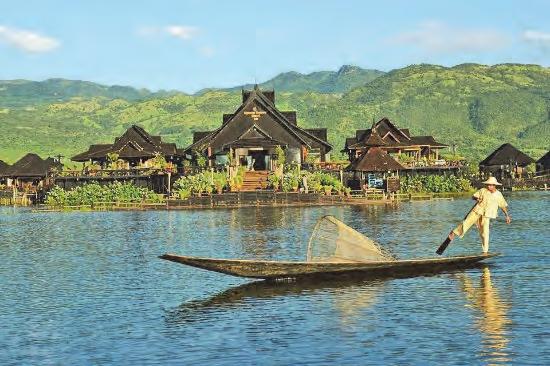
Who Needs To Work At The Guggenheim? By Marjorie Gilbert
Sure, the architecture seduces you - a stunning white spiral staircase –showcasing an avalanche of avant garde art –captivating the eye with splotches of color and zigzags, all crisscrossing each other like a subway map gone awry.
Who could resist a chance to train as a tour guide at the Guggenheim? A place to explain the inexplicable to anyone from everywhere, to those speaking anything and occasional English, knowing more or less, or absolutely nothing or everything about Impressionism and Expressionism.
When I applied for a tour guide role, I was told the one requirement for my interview was to study ONE piece of art in the Museum in order to present it as I would to a visitor. And that a training program would educate us for all relevant material. Fine. Immediately, I bought a Picasso art book in the Museum library and memorized verbatim the whole spiel behind The Girl with the Yellow Hair, a prominent Picasso work. Not a big deal. She looked half normal, if you discount multiple chins, crooked eyes and crazed facial expression. I even delved into my college texts to relearn the strange art world -altering styles of this brilliant, oversexed manly man, Picasso.
Admittedly confident, yet with forethought ,and wearing a damned stunning upper East Side looking outfit suitable for interviews and funerals, I march into the interview. John, the head of volunteers, looks like the head of the Yale bulldog parade: closely cropped dirty blond hair, waspy thin frame, cashmere sweater, tapered brown slacks. He reads my curriculum vitae, looks up and declares my suitability to the task under discussion.
Immediately, he reaches for a nearby art book, flips open a page at random, and says What’s that? My pulse speeds. All I see is white paper, a boat and numerous people who are ON the boat but appear to be PULLING the boat like they are dying of exhaustion. I don’t know who the hell they are ,I don’t care. I say “people on a boat”. Duh. He opens another page and pulls the same routine. I offer a similar you-don’t-say reply.
We’re off to a stunning start. I hate his guts. He can hardly slither out of his chair to accommodate his slipped disc. I offer to “just sit there and talk” rather than schlep around the Museum. NO is his reply with a muted reference to “my kindness”.
Walking to a series of tall, multi-colored canvasses replete with irregular and illogical lines and dots and diagonals, we stop, and he says “well”? I point to the paintings, and declare “Kokoschka – my college friend lived with him for over 10 years.” Intuiting that was the extent of my aesthetic interpretation, my creepy little friend ,now horrified, whips around and whines ‘You would never say that to anyone, would you?” – and obviously I , knowing full well that “what I just said” is the single most interesting fact about Kokoschka, say “OF COURSE NOT!”
Now I am anxious to get to the Girl with the Yellow Hair, I deserve it, I obsessively studied the freaking thing and yearn to show off my prowess. So, naturally, we walk directly to a David Smith piece of sculpture which looks like an escapee from a garbage dump. “What do you see?” he queries. Instead of “how the hell do I know”, I invent similes like “dejected piece of construction”, “steel or iron or geometric slabs with polished lines to give it strength” as I ad lib- ad infinitem. His slitty eyes dart sideways to me, I need a tums.
Next stop: a veritable who dunnit. Two tortured white slabs with bombastic diagonal black lines. I stare without uttering a syllable. He offers words which have fortunately escaped my memory, but sounded like “this one forces suggestion of surrender, that one realizes truth of idealization” - I offer a simple explanation like “well,to me it seems…….” And the next words I hear are :Do you always need to have the last word?” Stunned, I answer a banal “No”.
At some point, we meander over to the Picasso. I recite my carefully rehearsed analysis, excellent in my opinion, during which he stares around the room and in particular at a Kandinsky on the opposite wall.
I then strongly suggest we wind up the “test”. I escort him back to his office, and he introduces me to an intern, half my age, who “really knows her stuff”. I am admittedly humiliated enough to feel an undeniable urge to incapacitate his testicles.
A month later, a rejection arrives highlighting his comment that better qualified candidates have been accepted. Sometime later, I heard that the whole tour guide program had been replaced by acoustic guides and that this John person had left. What had I learned? That you don’t need to know what you don’t know, and that the guy was a freak.
TAKE YOUR GRANDKIDS ON A CRUISE ALONE…. IT CAN EVEN BE A GOOD IDEA!!!!! By: Marjorie Gilbert
Planning a cruise is smart thinking for people who may wish to avoid unnecessary air travel but still want a special family trip. When I tell my friends that I - just me - recently took my granddaughters, Madeleine and Melanie - ages 8 and 5 - on a three-day boat cruise from Los Angeles to Mexico, their response is instant disbelief: “WITHOUT THEIR PARENTS? ARE YOU CRAZY?”
Our cruise, my first solo with grandchildren, could have been a Harry Potter nightmare had we not enlisted ground rules which I firmly recommend for intrepid grandparents (see final page). While planning in advance may appear like a buzz kill, believe me, in the heat of battle one does not always think - so rules up front are your life saver.
Our adventure begins one day in July as we attempt to board the most enormous ship I’d ever seen. We spend two hours winding along a serpentine line of fellow passengers filling out forms and switching sweaty hands between hand luggage and guitar cases. Finally, we are allowed to walk on board. As we negotiate the route to our cabin, we face ten floors, four sets of elevators in varying locations, stairways too numerous to count, and 2,650 passengers scurrying around a seventy thousand ton vessel whose 700 crew members know absolutely that everybody is lost. Once located, our cabin proves more than adequate. In fact, it features a toilet which flushes like a bomb blast. On the bed is a bath towel folded like a rabbit.
Originally I believed this would be a cruise for families. Later, I learned this is a cruise for making families: the ship is named Ecstasy. According to the brochure, Ecstasy would “Make your cruise a memorable one with Your Kind of Fun.” Pleasure seekers have a wide range opportunities - board games, a camp for kids, slot and video machines, dance classes, sweet treats, “teen scene final blowout” in the Stripes Disco, and Hey Mambo Shows with Ziegfeld feathers and fluted fans. What I hadn’t expected was the bevy of bare-legged, hip swishing Baywatch babes busily gyrating to loud “hot cool and swing” music. Yet, for “my kind” there are seminars on anti-aging, eat more to weigh less, cellulite solutions, and aching back remedies. As for the kids, they seem oblivious to the more “mature” aspects of the cruise.
Day # 1 goes like a dream. The kids eat right, talk right, sleep right. They even act like troupers when Melanie pulls an ankle muscle charging down the corridor and Madeleine slams a heavy glass door against her head.
Day # 2 gets a bit dicey. Arriving in Ensenada, Mexico, we sign up for the “blowhole” tour. The girls especially want to see foam shoot up through an underground tunnel. A cheerful local guide herds us onto a bus which takes us to a refugee camp look-alike. Tents as far as the eye can see sell all manner of lures to eager tourists: beaded and silver jewelry, striped Indian blankets, handsomely decorated pottery, embroidered blouses, and Mexican team baseball caps. My two girls are satisfied with gorgeous dolls, gecko T-shirts and “fashionable-for-the-funky” toe rings.
As we re-board the bus and it leaves, I ask the guide when we’d be going to see the blowhole. She says “theees is the blowhole” which we never see since it is hidden behind the tents. But the worst moment is when she interrogates all the other passengers with “deeed anyone else not understand me except for theeees lady? I am sure not!” At least my two girls don’t cross their arms and glare. They don’t even tell me I’m not cool.
But on day #3, the darlings strike. They take their positions and FIRE. It was the talent show that started it. Since the love of Melanie’s life is show biz in the form of “ballet,” she jumps at the opportunity to display her talent. So, we register her at “cruise camp” where she spends the morning presumably practicing her steps, painting her face, playing pirate and going on a scavenger hunt. The treat of a lifetime, think I, querying her as she returns with: “Tell us everything - it was wonderful, yes?” Stone-faced and mute, she bunches up her mouth, raises her head like a queen and marches off. Efforts to find out what went wrong are rebuffed, and the silent treatment prevails.
At lunch, even the waiters notice the mood problem. To their credit, they, who are invariably kind, are now beseechingly attentive to Melanie. The Chicken McNuggets and fries don’t leave the plate, but at least they never hit the floor. Melanie practically has to be dragged to the cabin for a badly needed rest.
For an hour while Madeleine sleeps, Melanie lies on her stomach, elbows bent, resting her chin on her hands - all the while repeating her mantra: “I will not sleep, I will not sleep, I will not sleep.” Well on my way to hypnosis, I dress the diva for her upcoming performance in a long taffeta blue-green dress with bows and streamers, redden her pouting lips and create a Rita Hayworth coiffeur. The performance goes adorably as she tap dances her way across the stage between bows and assorted kicking movements. As she tips her hat and points her cane toward the audience, we respond lovingly with “yeahs” and “hurrays” in a flurry of applause.
AND THEN THE SUN COMES OUT, the first time in three days. I rush the little ladies out to the stern deck where it is surprisingly peaceful, and encounter their commentary: “This stinks - it’s boring - we’re going inside.” Of
course, they do just that. But knowing the hazards of leaving them unattended among 2,650 strangers any one of whom might be a serial killer, I stick with them. My mouth waters for fresh air and sunlight. I am burned out on newlywed games, karaoke and ice carving. And “Teen Scene Slammin’ Jammin’ Welcome Parties” have lost their appeal.
I take the upper hand. Pulling the girls this time to the bow deck, we are outside at last. We sight a pool with a thirty foot spiral slide, hot tub, and enough people to populate Chicago – all sprawled out and hanging over chaise lounges. Deftly dodging glass after glass of rum cocktails and pina coladas strewn over the deck floor, I make a beeline for the one unoccupied lounge chair into which I release my aching back. I then look up blissfully at the sun. Its heat soothes the incurable – my body. My immediate thought: “ An Affair to Remember” … visions of Cary Grant and Deborah Kerr on that glamorous cruise to Europe flash through my mind.
Immediately, I hear five frightening words: “I want my bathing suit.” So, all three of us wind through the labyrinth back to the cabin, then return to the deck. Again, I lie down. Thirty seconds later, the same five words emerge from the other child, so I don’t have to tell you the routine. Once back to my deck chair, I can hardly believe my ears: Melanie is demanding her suntan lotion, which of course is in the cabin. By then, I’m ready for a lobotomy but dutifully schlep back and re-emerge onto the deck – only to hear “Grandma, where are my glasses?” My fourth trip within one hour takes its toll big time.
So when I return, I’m into stress reduction. I actually join the mambo dancers and sway my spastic body to the soothing tunes of six maniacal steel band players. I am mesmerized by the sleek nymphoid bodies in rhythmic gyrations on the dance floor, and wonder if I should have had silicone implants myself before the Age of Managed Care.
A muscle pulls and I lie down. Spirits wilted, I look at my watch to see how many minutes I have left to live. And guess what – we have thirty measly minutes to get to our early seating dinner. Recovery mission aborted. We trek –now on remote control – back to the cabin. We’re in fast gear – shower, shampoo, dinner, pack and put suitcases out for early morning DEPARTURE!!
With 6,520 guests – or 2,650 – (who remembers?), the ship has efficiently arranged for disembarkation. Suitcase tags are color-coded. Our tag is a nauseating mixture of light tones, presumably orange. But when we go to the “orange” location as instructed, we learn that our color is actually another color – also of unknown hue. We are then sent to “yellows” – then to “browns” and finally to “beiges.” Each change of venue is a veritable obstacle course, especially since we are the only people going UP the stairs jammed with people
rushing DOWN. Knowing my horrendous sense of direction, Madeleine yells “That way!” Melanie yells “This way!” and I go into zigzag mode. Meanwhile, as I reach down to retrieve Melanie’s Mexican doll whose head is lolling down the steps, I lose my balance. Nothing breaks, but almost three hours pass – we’re still on the ship and logic dictates we will be in place for the next millennium. Yet, miraculously, we finally achieve the impossible and get off the ship with our luggage.
In retrospect, it was clearly not the fault of the cruise operations that we were “miscast.” The staff members were courteous, the ship was clean and programs were organized. The girls had their own comments. Madeleine loved the trip because “The ship was huge and amazing – and three waiters liked me.” Melanie said “It was good.”
But there WERE some hair-raising moments – which I am convinced could have been avoided had we employed some of the following do’s and don’ts:
• Set rules up front – before boarding • Predetermine bedtimes • No one stays alone in the cabin to sulk • Set daily deck time (one hour minimum for grandparents) • Reserve quiet time each day to rest or recover • Never be without sun block, band aids, room key, Kleenex, money • Leave ample down-time between activities • Let everyone do a favorite thing each day • Whole trip – three days tops
A grandparent alone CAN successfully travel with grandchildren. Best of all was hearing my phone machine when I got home: “Thank you, grandma, it was a neat cruise and we love you. When’s our next trip?” Soon, I hope, now that I know the ropes.

Melanie, Madeleine & Me

Trip to Washington By: Natalie Gorlin





Willard Hotel




